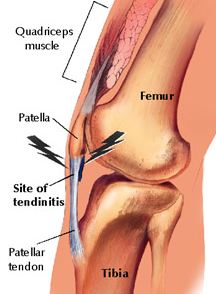Patellar Tendonitis
Tendonitis of the Patella (Knee)
Patellar tendonitis, also known as jumper’s knee, is an overuse/overload knee injury specifically affecting the patella tendon. What is the patella tendon? It is the tough band of fibrous tissue that connects the knee bone (patella) to the shin bone. It is essential for straightening your leg and crucial for athletic activities such as jumping, running or kicking a ball, not to mention day-to-day activities.
While a complete tear of the patella tendon is rare, tiny microtears to the patellar tendon are not, especially among athletes involved with sports that involve jumping, such as basketball, volleyball or some track and field events. For this reason, patellar tendonitis is also sometimes referred to as “jumper’s knee,” though this condition is not exclusive to “jumpers” or even to athletes.
Symptoms of Patellar Tendonitis
 If not given a chance to heal, these tiny microtears will result in inflammation and weakening of the tendon, with the outward displays of this including swelling, redness, and tenderness in the patellar tendon region.
If not given a chance to heal, these tiny microtears will result in inflammation and weakening of the tendon, with the outward displays of this including swelling, redness, and tenderness in the patellar tendon region.
Patellar tendon pain will be centered in the region the tendon is located—between the kneecap and shin bone. The onset of patellar tendonitis generally cannot be pinpointed; rather, it usually comes on gradually.
At the onset of the condition, patella tendon pain will generally occur only during activity. But if left untreated, the pain will develop so that it is present both during and after activity and it will eventually become performance-disrupting and even disruptive of day-to-day activities.
Several weeks of patella tendonitis without relief becomes known as patellar tendinopathy and it significantly increases the risk of a full patella tendon tear that often must be repaired via surgery.
Patellar Tendonitis Causes
Jumping is not the only activity linked to the development of patellar tendonitis. This condition can also be brought on by a sudden increase in activity—be it in terms of intensity or frequency.
Tight leg muscles can also be a contributing factor, as can uneven muscle distribution in the legs that can result in an uneven pull on the patella tendon.
Patella Tendon Pain Treatment
Treatment of patellar tendonitis depends upon how advanced the condition is. In the early stages, painkillers and the at-home RICE (rest, ice, compression, and elevation) are the go-to treatment methods for patella tendon pain relief.
A doctor might recommend physical therapy as both a treatment and preventative measure against re-injury. The stretches and exercises this treatment method entails will help to balance muscle strength in the leg and to improve muscle strength around the knee.
A doctor might also recommend a patellar tendon strap or patella tendonitis brace to help divert pressure away from the knee. He or she may recommend such patella support products as a stand-alone or supplemental treatment option.
Another patellar tendonitis treatment option is iontophoresis. This treatment method involves spreading corticosteroid medicine on the skin and then helping the skin to absorb it with a device that delivers a low electrical charge.
Patella Tendonitis Surgery & Injections
Alternatively, a doctor may try a corticosteroid injection to the patellar tendon sheath, but the increased risk of rupture this poses due to a subsequent weakening of the tendon, means this is not usually the first line of defense (See “Are Cortisone Shots for Tendon Injuries Worth It?”)
Another way to treat patella tendonitis is the injection of platelet-rich plasma into the affected region to stimulate healing.
If all else fails, a doctor may recommend surgery for those who have had patella tendon pain for the better part of a year. However, this is certainly not among a physician’s first line of defense.










